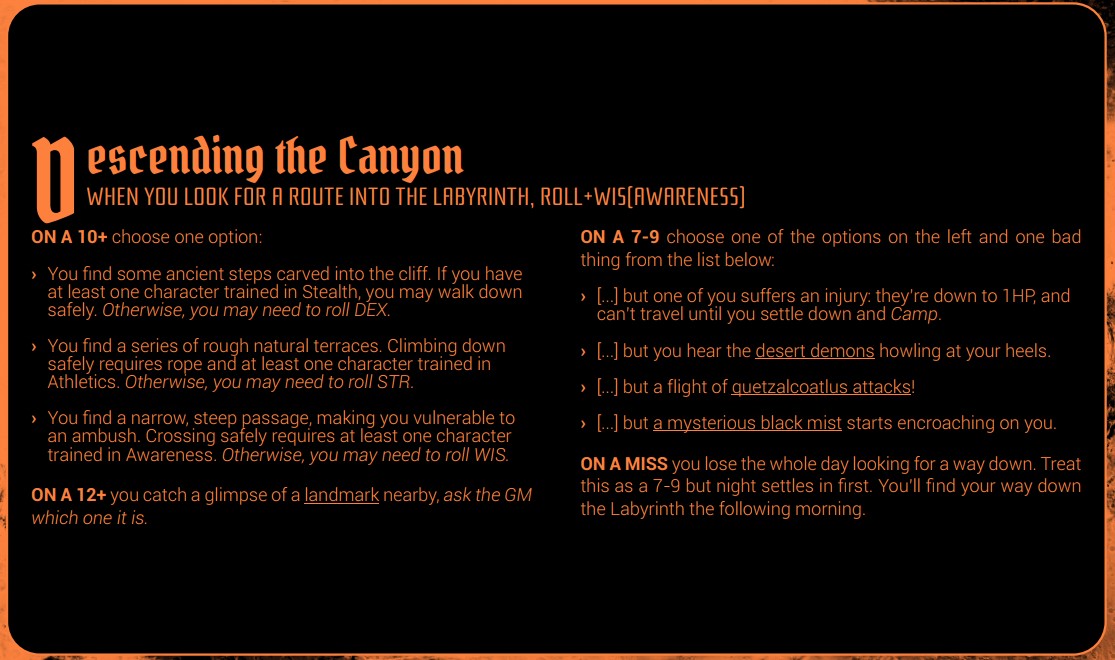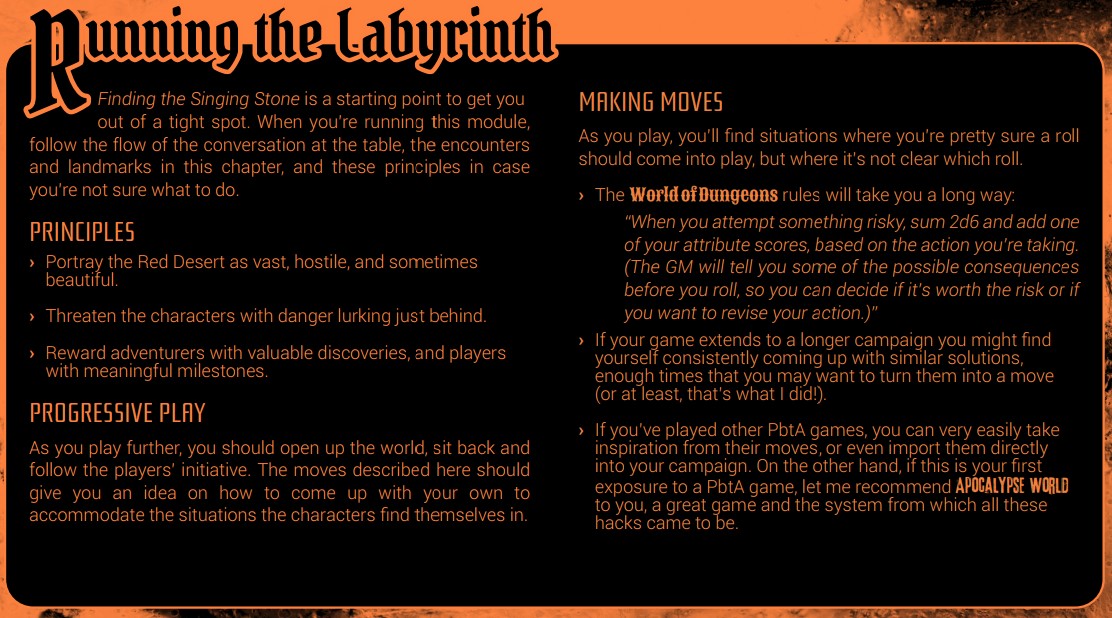Everything's Design 3: Powered by the Apocalypse
I've been an Apocalypse World fan for a long time now. AW was formative for me as a designer, particularly in its transparency of design: Meguey and Vincent took such care in teaching the reader how to tweak the game and make it their own, it's no wonder they facilitated a whole generation of game designers.
As the years go by I fear people are missing out on the gem that is Apocalypse World. If you wanna keen into what Powered by the Apocalypse is all about, read and play Apocalypse World. I can assure you, you'll come out a better designer off it.

So, why PbtA? Alright, World of Dungeons was my baseline, and it does a great job of framing OSR-style games in a PbtA language. In addition, WoDu was and still is free, and as a completely broke Argentinian GM running free games at our local community, WoDu was my game of choice to introduce new players.
But years went by since then, so again, why PbtA?
Well, because games are a conversation, and using a game that emphasizes conversations as the main format of play is, in my experience, the best way to introduce a person approaching RPGs to the act of playing an RPG. Conversational games are welcoming, peer-to-peer, and bring out play naturally. As new players sat down to play my open tables, we would start chatting, I would explain what RPGs are, or how WoDu was played as we waited for other players to arrive.
But improvising a new campaign every time new people got to our club can be taxing, specially week after week. So was Noctis Labyrinth born, as I developed ways to frame those conversations and to buy myself time to get to know new players and come up with a cool adventure without preparation. Here comes PbtA.
Moves
Moves work wonders to pause, pace and structure conversations. Even in text form, moves give you a structure that steadily gets turned into fiction:

A Strong Title Reminds to Trigger
When you do X is the trigger that invites to examine what is already happening in the fiction, then Y happens, prompts you towards the immediate consequence of such action.
Roll+Attribute calls for the player to act, to commit to their description and see the relationship between their character sheet and their character in play. As we check the results, we learn what the game has to say about this particular situation, and come to a resolution.
In addition, these spaces invite us to open worldbuilding to the whole group. As a move asks a question (and all do, some are just more explicit about it), it is a chance for the GM—who's traditionally viewed as a guardian for all answers—to lay back and find out what the other players have to say about the fiction, and what marks they leave in the setting.
These defined procedures let you tweak how a game is paced. For Finding the Singing Stone, the introductory, zero-prep adventure (and the hub for the whole book), moves gave me the chance to give the GM some time to breathe; to maybe skip ahead as the players talk through it and come to a decision; to reassess their creative surrounding and come up with something cool to ask next and keep the game moving forward.
Moves also work as a "unit" of conversation. In their structure, you can point when a move starts and when it ends, which creates a kind of fictional landmark. After a move something happened, and for an exploration game such as Noctis Labyrinth, those units of fiction (locations, events, anecdotes) can be used as markers as you navigate further into the adventure.
If we see moves as landmarks in the ongoing conversation that is playing an RPG, then we can weave-in the Weird. I've been talking about the Weird a lot, and I still have to actually address what I mean by Weird—and why it is necessary for Noctis Labyrinth—but that will have to wait. What I want to address right now is how PbtA structure of moves lets you go from the nebulous to the solid: from exploring the potential unknown, to solidifying that free, almost brainstorming conversation into tangible consequence. Moves that, the moment they end, opens up possibilities for new potential unknowns, which perpetuates a virtuous cycle in service of the Weird.
Fail Forward
We can't forget to mention how the Fail Forward nature of PbtA services the exploration needs of Noctis Labyrinth. I can confidently assert that without Fail Forward, exploration games just don't work, since momentum is a requirement of exploration. Fail Forward has thankfully become an established concept in TTRPG design, but it's always comforting to support your design in a framework that has been built with Fail Forward from the ground up.
GM Principles
Alright, I wrote a lot about moves, but PbtA goes far beyond that, and an often ignored piece of PbtA's design are GM Principles.
Principles might be one of the most fundamental aspects of PbtA, and the most influential to me. Nowadays I can't conceive a game that doesn't offer a set of parameters such as Principles to the GMs. I've lived through many games that left the GM's role completely abandoned, almost as if expecting GMs to come finish the job. Noctis Labyrinth ain't like that. NL's whole purpose is to help GMs out.
You can always change or ignore what's on a book, but for you to change or ignore it, it has to be there first. And if what's inside Noctis Labyrinth can help you run a solid game, that's... well, that's what game design is to me.

Due to the restrictions of a zine format, Principles in Noctis Labyrinth are additive. I wouldn't be able to give you a text that helps you run a no-prep game if I upfronted all that info. Principles are left for when you have extra time to sit down and read the whole zine. That's because you can run a session without Principles; Principles start becoming relevant with every passing session, helping you keep a direction in that nebulous potential unknown. Like I said, rules can always be ignored, but if you ever feel lost in the conversation, I wanted to have something for GMs to grab ahold. That's what Principles are.
- Portray the Red Desert as vast, hostile, and sometimes beautiful.
- Threaten the characters with danger lurking just behind.
- Reward adventurers with valuable discoveries, and players with meaningful milestones.
- Portray magick as powerful and wildly destructive.
- When play hits a lull, up the stakes.
- Make the characters’ actions matter.
- Describe the æthership as an alien and living space, filled with weird sounds and strange moving parts.
- Announce unexpected threats, and ask how the characters react.
- Present technology as almost indistinguishable from magick, but at the same time eerily familiar
I recognize that, yeah, these Principles are very focused on what each module of Noctis Labyrinth revolves around, but they also build up on each other. I trust any GM who runs the world of the Red Desert beyond the confines of Noctis Labyrinth to extrapolate and build around their own version of the game.
So yeah, here's my love letter to Apocalypse World, or more accurately, my short essay on how Noctis Labyrinth is a love letter to Apocalypse World. A game that taught me to never prep, and always play to find out what happens.
Get Noctis Labyrinth
Noctis Labyrinth
A Weird adventure for World of Dungeons
| Status | Released |
| Category | Physical game |
| Author | MRDR HOBO |
| Genre | Adventure, Role Playing |
| Tags | Dungeon Crawler, Fantasy, low-prep, OSR, PbtA, rpglatam, Sandbox, weird |
More posts
- Weird Fantasy 4: the WeirdDec 18, 2023
- Weird Fantasy 3: Science-Fantasy & Gonzo playNov 27, 2022
- Everything's Design 2: UnderwrittenSep 17, 2022
- Weird Fantasy 2: Implied settingAug 14, 2022
- Everything's Design 1: IllustrationAug 02, 2022
- Weird Fantasy 1 A Dialog with Anti-CanonJul 23, 2022

Leave a comment
Log in with itch.io to leave a comment.